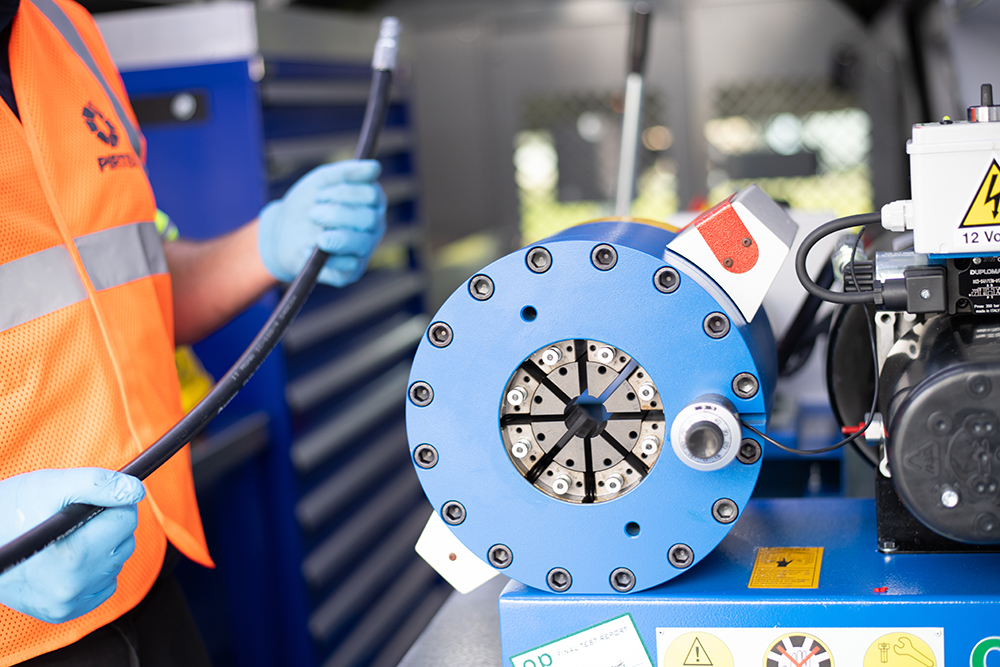In high-performance and industrial applications, the choice between push-lock hoses and traditional hydraulic hoses depends on several key factors, including ease of use, speed of installation, and overall operational efficiency. Push-lock technology, designed to streamline the assembly process without compromising performance, offers significant advantages by reducing setup time and minimizing the risk of leaks.
This article outlines the primary characteristics and usages of these two hose systems, focusing on their durability, cost implications, and performance to discern which better meets today’s industrial needs.
Overview of Push-Lock Industrial Hoses
Here is a detailed breakdown of the features and benefits of push-lock industrial hoses:
Quick and Secure Connection Mechanism
- Ease of Use: Push-lock hoses are designed for lower-pressure applications with an easy and quick assembly process, crucial in time-sensitive industrial operations.
Versatility and Adaptability
- Variety of Sizes and Materials: Push-lock hoses are available in multiple sizes and cater to diverse industrial needs, allowing users to select the optimal hose for their specific application.
- Suitability for Various Applications: Ideal for scenarios requiring frequent modifications, such as maintenance areas or temporary setups.
Installation and Maintenance
- Tool-Free Installation: Push-lock fittings require no special tools or equipment for installation, simplifying the setup and installation processes.
- Reusability and Cost Efficiency: These fittings are reusable, which can lead to long-term savings.
Specialized Applications
Industry Recommendations: Experts often recommend specific brands for push-lock systems to ensure maximum reliability and longevity.
Diverse Industrial Applications: Suitable for air lines, fuel lines, coolant lines, and many other applications, demonstrating their wide-ranging utility.
Overview of Traditional Hoses
Traditional hoses, while not as quick to assemble as push-lock hoses, offer a more robust solution for many industrial applications due to their proven reliability and durability. These hoses are available in various sizes and materials, catering to various needs.
Key Features of Traditional Hoses
- Connection Security: Traditional fittings are known for their secure connections, which are crucial in high-pressure or high-temperature environments.
- Application Suitability: Ideal for permanent setups due to their sturdiness and long-term reliability, making them a cost-effective choice where budget constraints are a concern.
- Material Variety: Available in rubber, thermoplastic, and PTFE materials. Each offers distinct advantages in durability and flexibility.
- Diverse Applications: These hoses serve various sectors effectively, from chemical transport to food and beverage services.
With their extensive range of applications and proven track record, traditional hoses remain a valuable choice for many industries, particularly where durability under high pressure or temperature is required.
Durability and Reliability
Traditional hoses are celebrated for their robustness and enduring reliability. They are often made from diverse materials catering to various industrial demands. These hoses have a solid track record, particularly under high pressures and temperatures, where durability is paramount.
On the other hand, push-lock hoses, while acclaimed for their quick assembly and efficiency, present a mixed picture when it comes to long-term reliability. User experiences vary significantly; some report issues with durability under continuous high-pressure usage, while others appreciate the time-saving benefits and ease of use.
A closer examination reveals that the longevity of push-lock hoses can be influenced by several factors, including the application environment, pressure ratings, impulse cycles, and the compatibility of both the hose and its fittings. Traditional hoses generally maintain their integrity better than push-lock hoses in high-pressure scenarios.
This comparison underscores the importance of selecting the correct hose type based on specific operational conditions and requirements. While push-lock hoses offer significant advantages in speed and ease of installation, in lower-pressure applications, traditional hoses stand out in environments requiring sustained durability under harsh conditions.
Cost Implications
Cost Variability and Initial Investment
- Cost Range of Push-Lock Hoses: Push-lock hoses, known for their quick assembly process, vary in price based on length, material, and quality. This variability can influence budget considerations, especially for large-scale or specialized industrial applications.
- Long-Term Cost Efficiency: Considering long-term usage, push-lock hoses might offer cost savings due to reduced labor costs and downtime, thanks to their ease of assembly and maintenance.
By evaluating these cost implications, industries can make informed decisions that balance initial expenses with operational efficiencies and long-term savings. This analysis is crucial for optimizing budget allocations and ensuring that the chosen hose type aligns with specific industrial needs and financial constraints. If you have questions about which type of hose is best for your industrial application, go to our locations page, find your closest service center, and call us.
Performance Comparison
This section will detail the operational capabilities of each, evaluating factors such as flow rates, pressure handling, and ease of installation.
Decision-Making Factors
Choosing between push-lock and traditional hoses involves considering specific operational needs, including budget, time constraints, and safety requirements. The decision hinges on whether the quick assembly process features of push-lock hoses outweigh the proven durability and cost-effectiveness of traditional hoses in a given application.
Advantages in Specific Applications
 Safety and Efficiency in Construction Equipment
Safety and Efficiency in Construction Equipment
Hydraulic hoses crafted from materials such as rubber, thermoplastics, and Teflon are pivotal in powering heavy machinery like excavators and bulldozers. These hoses enhance the machinery’s efficiency, which is crucial for demanding construction tasks. Adhering to rigorous maintenance routines maximizes hose performance, minimizes downtime, and extends their operational life, making them a preferred choice in construction for their robustness and reliability.
Enhanced Safety Protocols
The handling of hydraulic hoses involves strict safety measures to protect workers and equipment. Using appropriate personal protective equipment and following proper procedures, such as depressurizing the system and inspecting hoses before use, are essential. These practices not only prevent accidents but also align with regulatory compliance, safeguarding against potential hazards like high pressure and chemical exposure.
Application-Specific Recommendations
For automotive applications, such as fuel lines, braided lines are recommended to offer additional protection against road debris. This specific use case highlights the adaptability of hose systems to meet unique environmental challenges, providing an extra layer of security and durability where it is most needed.
By integrating these specific applications and safety measures, industries can leverage the full potential of hydraulic hoses, ensuring optimal performance and safety in high-stakes environments. This detailed focus on application-specific advantages underlines the necessity of choosing the right hose type—be it push-lock or traditional—based on operational demands and safety requirements.
Conclusion
Industries must weigh these factors carefully when selecting between push-lock and traditional hose systems, considering the overarching implications for both operation and maintenance. The choice fundamentally hinges on the specific requirements of each application, be it the need for speedy installation and flexibility provided by push-lock hoses or the rugged, dependable service traditional hoses offer.
PIRTEK’s push-lock and hydraulic hoses are designed to meet and surpass the demanding requirements of today’s industries. For those looking to service or upgrade their systems with reliable and cost-effective solutions, we invite you to explore the robust offerings of PIRTEK. Are you looking for a specific hose, fitting, adapter, or other hydraulic product? Visit our digital catalog for a comprehensive listing of immediately available and special order components. Contact us today to discuss how our products can enhance your operational efficiency or to address any specific needs with our expert team. Visit our locations page to find your local PIRTEK and let PIRTEK help you optimize your operations with our industry-leading solutions.



 Safety and Efficiency in Construction Equipment
Safety and Efficiency in Construction Equipment